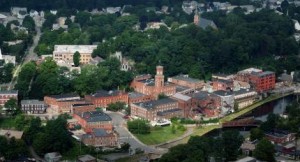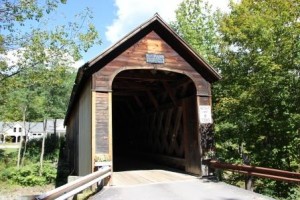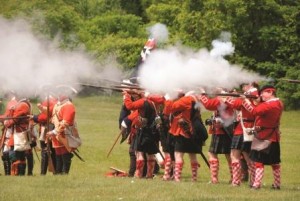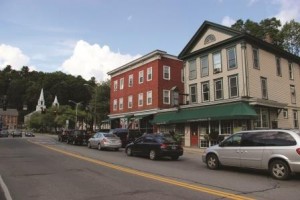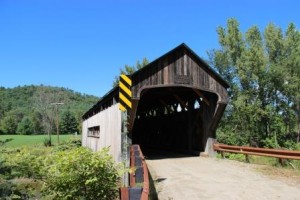13 Bellows Falls Canal, Depot Street, Bellows Falls, Vermont
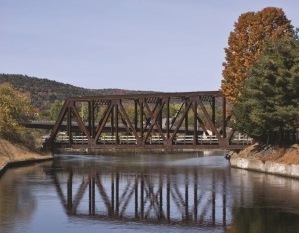 Bellows Falls Canal, built along the Connecticut River, was the first United States canal company chartered in 1791, to provide power to mills and allow lumber and barges to bypass the gorge through a series of locks.
Bellows Falls Canal, built along the Connecticut River, was the first United States canal company chartered in 1791, to provide power to mills and allow lumber and barges to bypass the gorge through a series of locks.
14 Bellows Falls Downtown Historic District, Bellows Falls, Vermont
The “Great Falls” area, settled in 1753, was later renamed after local landowner Colonel Benjamin Bellows. Today, the Bellows Falls Downtown Historic District encompasses the central village together with surrounding railroad and industrial areas significant to its historical development, including Depot, Canal, Rockingham, Bridge, Mill and Westminster Streets.
15 Moore and Thompson Paper Mill Complex, 33 Bridge Street, Bellows Falls, Vermont
From the 1870s to 1920s, Bellow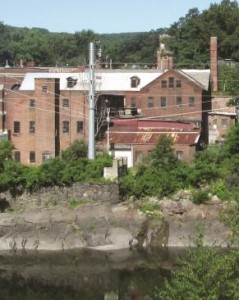 s Falls, Vermont was one of New England’s largest industrial centers, with the Moore and Thompson Paper Mill playing a vital role in its prosperity. Today, the Moore and Thompson Paper Mill remains as one of the last surviving manufacturing complexes that encompassed the 30-acre “island” created by the Bellows Falls Canal.
s Falls, Vermont was one of New England’s largest industrial centers, with the Moore and Thompson Paper Mill playing a vital role in its prosperity. Today, the Moore and Thompson Paper Mill remains as one of the last surviving manufacturing complexes that encompassed the 30-acre “island” created by the Bellows Falls Canal.
16 Hall Covered Bridge, Hall Bridge Road, Saxtons River, Vermont
Hall Covered Bridge was replaced in 1982 with a 120-foot design of traditional materials and timber framing methods, following its 1980 collapse due to the crossing of an overweight vehicle.
17 Saxtons River Historic District, Route 121, Village of Saxtons River, Vermont
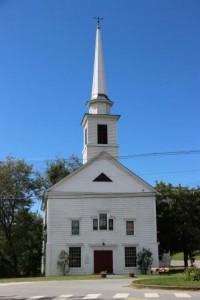 Saxtons River Village, within the town of Rockingham, was settled along the river of the same name in 1783. While the Village began as an agricultural center during the later 18th century, the settlement site served as an ideal location to capture the water power along the half-mile stretch of river.
Saxtons River Village, within the town of Rockingham, was settled along the river of the same name in 1783. While the Village began as an agricultural center during the later 18th century, the settlement site served as an ideal location to capture the water power along the half-mile stretch of river.
18 The Walpole Academy, 32 Main Street, Walpole, New Hampshire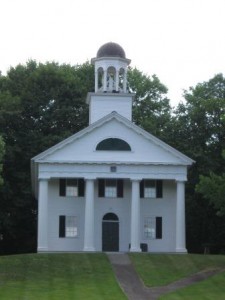
The Walpole Academy, added to the National Register of Historic Places in 1975, sits on a knoll overlooking Main Street and provides a home to the Walpole Historical Society.
19 Langdon Meeting House, 121 Route 12A, Langdon, New Hampshire
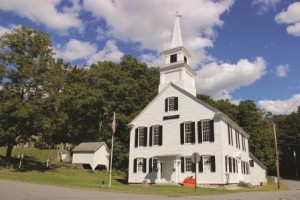 From the first town meeting held in the newly built Langdon Meeting House in 1803, community members have been gathering at this same location for over 210 years, marking a New Hampshire State record for the most consecutive town meetings conducted in the same building.
From the first town meeting held in the newly built Langdon Meeting House in 1803, community members have been gathering at this same location for over 210 years, marking a New Hampshire State record for the most consecutive town meetings conducted in the same building.
20 Charlestown Main Street Historic District, Charlestown, New Hampshire
Charlestown was chartered in 173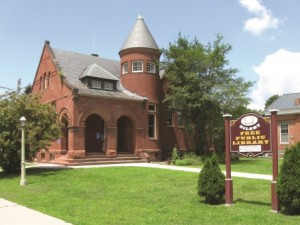 5 by the Colony of Massachusetts Bay as Plantation No. 4, the northernmost township along the Connecticut River. Today, its quaint Main Street is the longest New Hampshire historic district recognized by the National Register of Historic Places.
5 by the Colony of Massachusetts Bay as Plantation No. 4, the northernmost township along the Connecticut River. Today, its quaint Main Street is the longest New Hampshire historic district recognized by the National Register of Historic Places.
21 The Fort at No. 4, 267 Springfield Road, Charlestown, New Hampshire
Through the French and Indian War, Fort at No. 4 was the northernmost British settlement along the Connecticut River in New Hampshire. During the American Revolution, the Fort served as a critical fortress and supply stop. Today, the Fort has transitioned to become a living history museum to educate students and visitors about life in New Hampshire and New England during these defining moments in the history of the United States.
22 Crown Point Military Road, Vermont
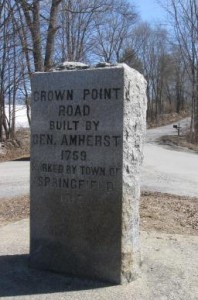 Across Vermont a chain of markers stretches from the bank of the Connecticut River to the shore of Lake Champlain. While erected at different times and by different people, the markers serve as a visual reminder for Crown Point Military Road.
Across Vermont a chain of markers stretches from the bank of the Connecticut River to the shore of Lake Champlain. While erected at different times and by different people, the markers serve as a visual reminder for Crown Point Military Road.
23 Springfield Historic District, Routes 11 & 106, Springfield, Vermont
The list of machine tool inventors and entrepreneurs who honed their skills and made Springfield, Vermont their base of operations along the Black River’s natural waterfalls, during the Industrial Revolution, reads like a “who’s who” of American ingenuity.
24 Eureka Schoolhouse, 140 Charlestown Road, Springfield, Vermont
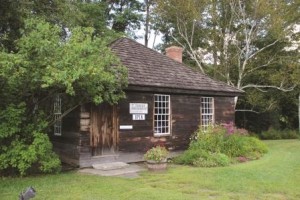 As villagers in Springfield built their one-room schoolhouse in 1790, David Searle, their first teacher, claimed the honor of naming the school. Upon reaching the village settlement and seeing the new schoolhouse, he exclaimed, “Eureka!” meaning “I have found it” in Greek. The Eureka Schoolhouse is the oldest surviving schoolhouse and one of few remaining 18th century public buildings in Vermont.
As villagers in Springfield built their one-room schoolhouse in 1790, David Searle, their first teacher, claimed the honor of naming the school. Upon reaching the village settlement and seeing the new schoolhouse, he exclaimed, “Eureka!” meaning “I have found it” in Greek. The Eureka Schoolhouse is the oldest surviving schoolhouse and one of few remaining 18th century public buildings in Vermont.
25 Worrall Covered Bridge, Williams Road, Rockingham, Vermont
The 1868 Worrall Covered Bridge, which crosses the Williams River, is one of only three original bridges, designed by Sanford Granger, still in existence in the town of Rockingham.
26 Rockingham Meeting House, 11 Meeting House Road, Rockingham, Vermont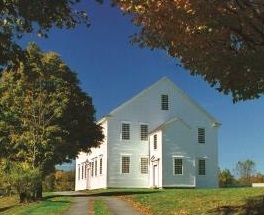
During the 18th and 19th centuries, local meeting houses protected and supported the religious and political lives of its New England residents. For a truly authentic and historic glimpse into the look and feel of a meeting house, visitors can tour Rockingham Meeting House, Vermont’s oldest public building in its near original construction.
